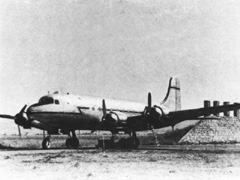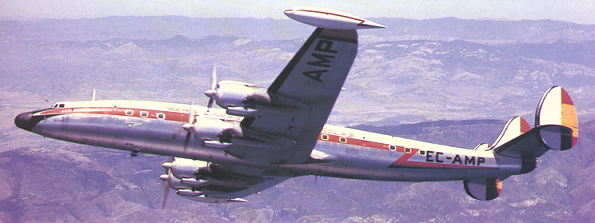
The DC-4 was first conceived in 1935 and a protype DC-4E first flew on June 7th 1938. This tri-finned design however, was overly complex and Douglas turned its attention to a more practical unpressurised airliner, the DC-4A. This aircraft was overtaken by World War II and the USAAF commandeered the first 24 production aircraft which entered service as the C-54 Skymaster long range transports. Besides the 1,236 military C-54s, 79 more DC-4As were manufactured after the war. The type was also operated by the RAF and the Royal Canadian Air Force.
In December 1947 and early 1948, Haganah (pre-indepence Jewish defence force) agents in Czechoslovakia managed to acquire much needed arms for the Israeli War of Independence which broke out in late November 1947. Czechoslovakia however, has no sea port and none of its neighbors would let the cargo to pass through. Furthermore, the British, still in control of Palestine, also controlled Palestine's sea routes and ports. The urgent need for the weapons and ammunition spurred the Haganah to seek transportation by air.
An American Company, "Ocean Trade", agreed to perform the cargo flight from Europe to the former British air base at Beit-Daras. On March 31st 1948, a Douglas C-54 Skymaster landed in Prague and took on the cargo. The aircraft, code named "Balak-1", then took off again and proceeded to fly to Palestine under the cover of
darkness. For a single night, the abandoned air base came back to life for the sole purpose of a single aircraft, about to land, unload its cargo and then leave right back again. On the ground, 4 kms of light bulbs were rolled out at Beit-Daras to provide illumination for the incoming flight. Once the
aircraft had landed the landing lights were switched off and in an hour and a half the weapons were unloaded, the landing lights switched back on and the Skymaster departed for Prague. All this had gone on under the noses of a British military unit and Arab villages in the vicinity. This method of transportation would have
been employed again had the crew of the Skymaster not been arrested upon their return to Prague. Accused of supplying arms to Italian communists, they admitted to ferrying medical supplies to Palestine and were cautioned against ever flying back to Palestine again. The crew were however willing to continue their flights provided they did not originate from Czechoslovakia and on May 12th left Corsica with another weapons-ladden Skymaster, the first of many. Among the cargo flown to Palestine on this aircraft, "Balak-2", were two examples of the IAF's first fighter, the Avia S.199, the first of which landed at Ekron (now Tel-Nof) AFB on May 20th.
On May 15th 1948, a day after the Israeli declaration of independence, the IAF purchased two C-54 Skymasters of its own. While their primary role was transportation of supplies for the war effort, they also went on a number of bombing raids and in late September escorted Israeli Spitfires on delivery flights from Czechoslovakia.
Specification: Douglas C-54D Skymaster
Type: four-crew medium range personnel and freight transport.
Powerplant: 4 * Pratt & Whitney R-2000-11.
Performance: max speed - 426km/h, range - 5,300km.
Weights: empty - 17,000kg, max takeoff - 33,113kg.
Dimensions: span - 35.81m, length - 28.60m, height - 8.39m.
Armament: none.
The biggest, most powerful and most expensive of all airliners of its time, the Constellation first took to tha air on January 9th, 1943. It was designed as a civil airliner for TWA but when commercial production ceased after Pearl Harbor, it entered service with the US Army Air Force as the C-69. While the type became one of the most successful post war airliners, the military variants outlived the civilian Constellations, serving around the world until 1980.
The Constellation was the IAF's biggest and fastest transport during the War of Independence but was only in service for a very short time. Three ex-USAAF C-69 were purchased in the U.S by a fictional Panamanain airline acting as a front for Israeli acqusition agents in an effort to bypass the American embargo on weapon sales to the opposing sides in the Middle East. Only one Constellation managed to leave the U.S for Panama and from there to Czeckoslovakia (on March 13th 1948) where Israel had set up a base for cargo flights to Israel. The other two Constellations were apprehended by the FBI and were only allowed to leave after the end of the war, too late to enter service with the IAF. The lone C-69 flew cargo flights to and from Israel, participating in operation "Balak" to arm Israeli defenders of the new born state, but was retired after a mechanical failure. All three Constellations were handed to Israel's national carrier El Al, one El Al Constellation was brought down over Bulgaria on July 27th 1955 by anti aircraft fire, killing all on board.

Specification: Lockheed C-69 Constellation
Type: four/five crew long range personnel and freight transport.
Powerplant: 4 * Wright R-3350-35 Radial engines.
Performance: cruising speed - 410km/h, max speed - 520km/h, rate of climb - 1620 ft per minute, service ceiling - 24,600ft, max range - 3670km.
Weights: empty - 22907kg, max speed - 39123kg.
Dimensions: length - 29m, span - 37.48m, height - 7.21m.
Armament: none.
The Noorduyn Norseman was designed and built by Noorduyn Aviation Limited of Montreal as a light transport airplane convertable to wheels, skis or floats. The first Norseman built was delivered to the Royal Canadian Mounted Police in 1938 and in May of the same year deliveries begun to the Royal Canadian Air Force. The RCAF employed the Norseman in a variety of roles, such as bombing trainer and communications trainer, and the last Norseman was only retired in 1954. 759 examples were also supplied to the U.S. Army Air Force where the type was particularly well known for its work as an ambulance plane. Noorduyn Norsemen continue to fly today, used by commercial operators around the world.
In early 1948, word had reached Israeli acquisition agents in Europe of an American Jew selling surplus USAAF aircraft and by early April a deal had been agreed upon for the delievery of 20 Norsemen : 5 in april, 7 in May and the remaining 8 later on. The first aircraft were flown from Germany to a KLM workshop in
Amsterdam where additional fuel tanks were installed for the long flights to Palestine, while others underwent the same installation in a French airport. The first 5 Norseman were ready by the last week of April and left their various points of origin for Rome. On May 2nd the first pair left Rome for Palestine
and after an 11.5 hours flight landed at Sde-Dov in the midst of the Israeli War of Independence. They were already flying operational sorties the following day, dropping supplies to the besieged region of Gush Ezion. 17 Norsemen made it to Palestine, one had crashed in Italy killing both pilots, while two more had mistakenly landed in Gaza and were captured by the Egyptian army. The Norsemen
formed the 32nd transport section at Ekron AFB and while they usually flew personnel and cargo flights, they were also employed on a number of bombing missions. Norsemen bombed the Gaza and Rafiah on at least one occasion and were also employed during operation "Nahshon", the breakthrough to Jerusalem.
On May 7th two Haganah brigades launched operation "Maccabi", attacking Palestinian strongholds along the road to Jerusalem. On May 10th one Norsemen was called in to assist the "Har'el" brigade in its attack on Beit Mahsir. The Norseman was equipped with a new and experimental 200kg bomb and left with a crew of six men. The plane had reported it was going into its bombing run when radio contact was lost and the aircraft disappeared. For reasons unknown it had crashed into a mountain side near Beit Mahsir. Speculation as to the cause of the crash included adverse weather conditions or the bomb rolling free of its mooring, British fighters in the vicinity could also have shot the aircraft down. Only after the area was captured six months later were the aircraft remains found. Subsequently, the engine and bent propeller were brought to a nearby hill and set up as a memorial to the fallen of the Israeli Air Force. Once a year members of the IAF come to "Airmen's Hill" for a memorial service to all IAF casualties, of which the Norsemen crew were the first.
The Norsemen suffered from a lot of stractural fatigue and were often grounded. The type was retired soon after the end of the war. By July 1950 there were only 3 left, all in the process of being phased out.
Specification: Noorduyn UC-64A Norseman
Type: 10 seat (2 crew) light personnel and freight transport.
Powerplant: one Pratt & Whitney Wasp R-1340-AN-1 engine.
Performance: max speed - 260km/h, cruising speed - 238km/h, range - 1,851km, service ceiling - 5,181m.
Weights: empty - 1,900kg, max takeoff - 3,356kg.
Dimensions: length - 9.68m, height - 3.07m, span - 15.70m.
Armament: none.
The DC-5, first flown on February 20th 1939, was a twin engined high-wing transport which embodied many DC-3 systems.
It enjoyed only limited success and only 12 were built, 5 as commercial DC-5 transports and 7 as R3-D military transports.
The IAF's sole DC-5, VH-ARD, begun its life with KLM in the Dutch West Indies. During World War II the aircraft was operated in the
Far East and was sold to an Australian operator once the war was over. For a while the aircraft was used to ferry Italian
immigrants to Australia, until it was procured by Israeli agents in Sicily.
The DC-5 arrived in Israel in June 1948 and was apparently operated by the 103rd transport/bomber Squadron.
Flown by foreign volunteers, it was nicknamed "Bagel Lancer The Yankee Pasha" and had the name stenciled below
the cockpit. The aircraft was in service for only a short time before a lack of spares and its poor mechnical
state forced its retirement. Its very last mission, probably flown sometime in July 1948, saw the DC-5 team up with the IAF's newly acquired
B-17s to bomb Arab positions overlooking Israel's coastal road, rolling bombs out of the rear loading door.
The aircraft ended up in the IAF Technical School in Haifa, although what later became of it is unknown.
a page dedicated to "Bagel Lancer The Yankee Pasha" can be found at www.hard.net.au/users/incoll/bagel.htm
Specification: Douglas DC-5 back to the IDF/AF page
back to the IDF/AF page